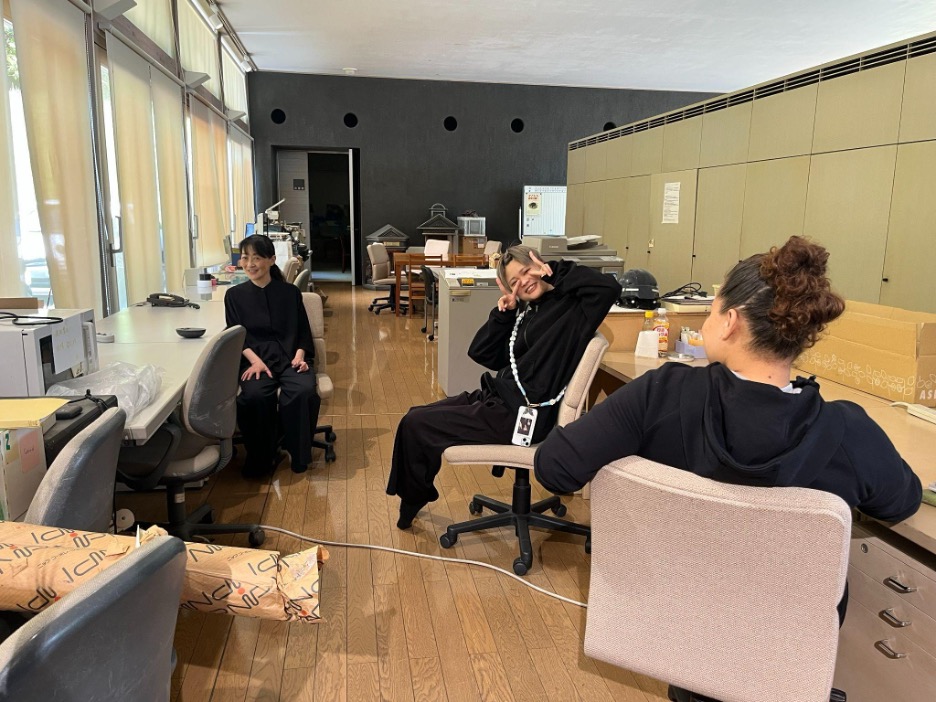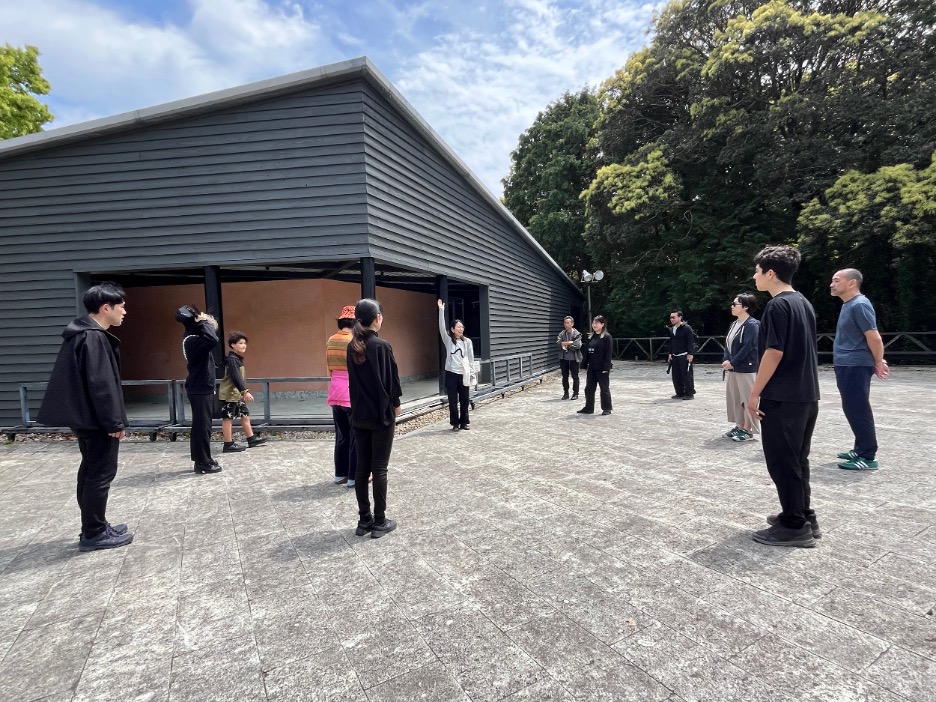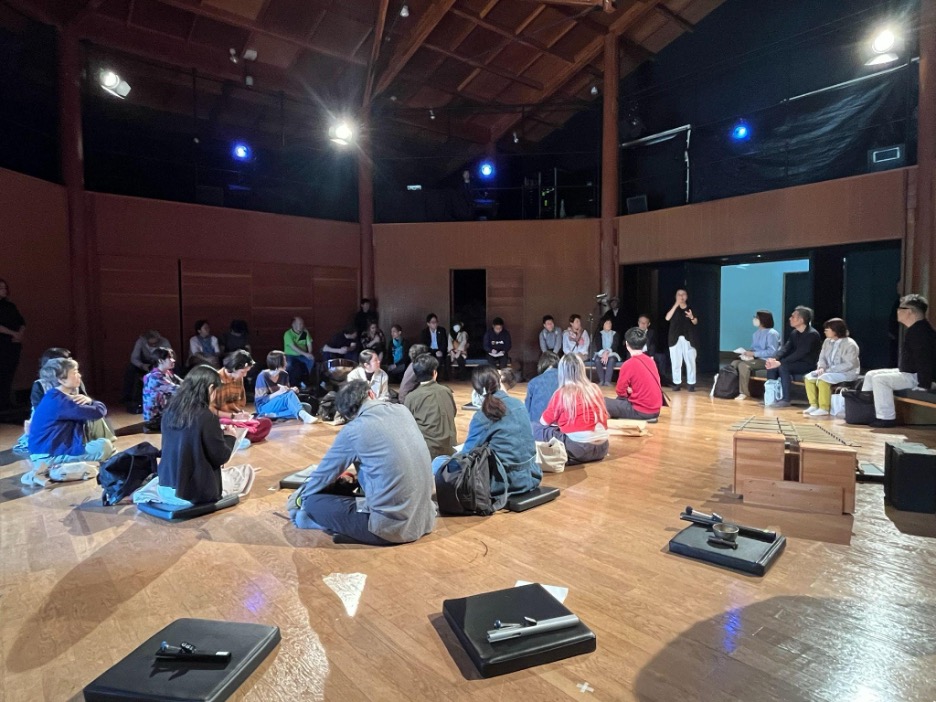うなぎはどこで生まれるか、ご存じですか?
うなぎは日本の沿岸から何千キロも離れた海で卵を産み、命を終えます。
孵化した稚魚は長い旅を経て、日本の淡水域へと戻ってきます。
SPAC-静岡県舞台芸術センターの新たなプロジェクトでは、劇作家・石神夏希さんのもと、SPACの俳優と静岡に住むブラジルにルーツを持つ出演者たちが、この不思議な魚の旅をモチーフに演劇を通じて新たな物語を紡いでいます。
〜演劇は、自分が生まれるよりもずっと前に始まった物語を引き継ぐ、唯一の方法だ〜
■ オープンスタジオ当日の朝
2025年4月29日と5月5日、いよいよオープンスタジオ本番の日がやってきました。来年の「SHIZUOKA せかい演劇祭 2026」で発表される予定の本公演に先駆けて、その「核」となるエッセンスを限定公開で披露する機会です。
朝の最終リハーサルが終わり、9時40分にはすべての準備が整いました。あとは観客を迎えるだけ。
舞台芸術公園「本部棟」の窓から、楽器演奏チームと私は観客が野外劇場「有度」の前に集まりはじめた観客たちの姿を眺めていました。やがて劇場バスが到着し、人の流れがぐっと増え、ちょっとした群衆のように見えてきます。
SPACの俳優・森山冬子さんが「手のひらに十字を描いて、それを3回食べるといいのよ」とおまじないを教えてくれたり、同じくSPAC俳優の吉見亮さんが「観客全員をじゃがいもだと思えば大丈夫」と笑いながら言ってくれたり。私もフランス式に “Merde!”(がんばって!)とエールを送りながら、そのフランス由来の験担ぎについて説明しました——SPAC俳優の彼らはすでに、アヴィニョン演劇祭に何度も参加しているので知っていたけれど。本部棟の屋上でモノローグを行う参加者の1人は、「このプロジェクトのおかげで、自信を取り戻せた」と話してくれました。その言葉と表情に励まされて、私の心もすっと落ち着いていきました——
きっとすべてうまくいく!

オープンスタジオ本番前、「本部棟」内で出番をまつメンバーたち
およそ10分後、その朝に集まった40人ほどの観客——「SHIZUOKAせかい演劇祭」フェスティバルパートナー、プロデューサー、舞台関係者、記者、俳優たち——が、石神夏希さんの声に耳を傾けていました。
彼女は『うなぎの回遊』プロジェクトの成り立ちを語り、そして観客を野外劇場へと導く案内で「旅」が始まります。
観客たちはまるで海を渡るうなぎのように、音楽と語りによる「回遊」に巻き込まれていきます。茶畑を抜けてたどり着いた先は「稽古場I」。その空間は、まだ生まれていないうなぎたちの「水中のふるさと」を思わせる象徴的な場所です。
その日、富士山は稽古場の入口からくっきりと見え、天候も完璧でした。すべてが予定通りに進行したのです。

本番前の通し稽古で観客を出迎える順序を確認する石神さん
上演後のアフタートークでは、こんな質問が投げかけられました——
「どうやってうなぎと音をつなげたの?」「うなぎって本当に絶滅危惧種なの?」「ブラジルではうなぎを食べるの?」
芸術の問いと、科学の問いが交差する時間。中央大学でうなぎの研究をされている海部健三教授がゲストとして招かれ、科学的な側面からの質問にも丁寧に答えてくださいました。
こうして、フィクションである演劇が現実の生き物や生態系への関心を引き出し、私たちを「生きているもの」へと再び結びつけてくれるのだと実感しました。
最後には、石神さんがプロジェクトの参加者たちを紹介し、それぞれが簡単な自己紹介と、この創作への想いを語りました。どの言葉も誠実で、観客からは大きな拍手が送られていました。

オープンスタジオ終演後 —— 観客との語らいの時間
5月5日の2回目の上演をもって、オープンスタジオの冒険は一区切りを迎えました。
今後もまたメンバーは集まり、創作は続いていきますが、この春の「最初の一歩」は、たしかにここで完結したのです。
稽古初日からずっと続けてきたように、私たちは輪になって座り、それぞれがオープンスタジオを通じての体験をどう感じたかを共有しました。その時間には、静かな感動が満ちていました。
県民出演者の皆さんにとって、自分の言葉を表現し、誰かがそれに耳を傾けた、という経験は、とても特別なものだったのではないかと思います。
彼女たちがぽつりと語るのは、「違う」という感覚——そのために、どこか自分が足りないように感じてしまうことがあるということ。でもこの場で過ごすうちに、「ここにいてもいいんだ」と、思えた……そんな気持ちが、彼女たちの言葉の端々から伝わってきました。
ひとりひとりの言葉のなかに、この創作の一部でいられることへの誇りがにじんでいました。
「まだプロジェクトは始まったばかりですよ!」SPACの俳優チームは、そう笑顔で応えてくれました。
そして今、あなたが「この先『うなぎの回遊』はどうなるんだろう?」と気になっているなら——どうぞ、『うなぎの回遊』の続報を追いかけてみてください!
誰かのスピーチを聞いているうちに、気づけば目に涙が浮かんでいました。謙虚さと感謝が入り混じったような、不思議な感情が胸を満たしていきます。
オープンスタジオの旅が、私にとってもこれで一区切りなのだとしたら——それでも、私はこの時間に、深く心を動かされました。
何週間も、フランスの家から15,000キロも離れた場所で過ごすなかで、「旅」と「根づき」というテーマが、どこか自分自身のことのように響いてきました。
この経験のおかげで、私はあらためて気づいたのです。
演劇を愛してきた、その根っこの気持ち。この国とその人びとと、まっすぐにつながる喜び。そして、言葉も背景も違うはずなのに、驚くほど多くを分かち合える仲間たちの存在。
私は今、思い出とともにこの場をあとにします。
演劇とは何かを語った夜、20世紀の振付家について語り合った時間、いただいた贈り物、演劇祭で観た作品についての感想の交換、トーンチャイムやチベタンボウルの音、新しく覚えた日本語、即興のサルサ、料理の話-
すべてが詰まったスーツケースを持って、私は出発します。
忘れられない、そしてこれからもずっと大切にしたい時間を胸に。
もしかしたら、あの稽古場はー
私にとっての「生まれ(変わっ)た場所」だったのかもしれません。
◼️自己紹介
私の名前はエレーヌ。フランスで5年ほどフランス国立の劇場でのスタッフとして経験を積んだ後、「自分を自由にする」ため、日本へやってきました。ご縁あってSPACの皆さんに迎えていただき、、石神夏希さんが演出し2026年春に初演を予定している『うなぎの回遊』の 創作初期に数週間、同行する機会をいただきました。
ENGLISH
FOLLOWING UP EEL MIGRATION
Part IV :The Open Studio
Have you ever wondered where eels are born?
Eels lay their eggs thousands of miles from the Japanese coast, and die once it pours out its seed. Once the baby eel is out of its shell, it travels back to Japan to live in the country’s fresh waters.
In this new project by the Shizuoka Performing Arts Center, director Natsuki Ishigami brings together actors from SPAC and non-professional actors with roots in Brazil who live in Shizuoka, to explore the fascinating journey of these fascinating 100-million-year-old fish.
‘Theatre is the only way to take up a story that someone else started long before I was born’
◼️The Open Studio
It is officially the big day(s). On April 29 and May 5, the Eel Migration project team performed in front of a restricted audience to present the core of what the show will be in 2026 during the World Theater Festival Shizuoka. In the morning, the entire team holds a final rehearsal to ensure that everything is on set. At 9:40 am, everyone is ready and waiting for the audience.
From the main office windows, the musicians and I watch the spectators gather in front of the doors of the open-air theatre. As the audience is starting to get bigger and bigger, it starts to look like a real crowd when the bus from the theater arrives. I recognize some of the French professionals of performing arts, and suddenly feel irrationally stage fright. Fortunately for me, during this moment they call stand-by when we all wait, I am not alone to face the stress. Fuyuko Moriyama, one of the SPAC actresses, shows me how to make a cross in the palm of my hand and eat it, three times, whereas Yoshimi Ryo, one of the actors, tells me a Japanese technique: “You just have to imagine that everyone in the audience has a potato face.” On my part, I wish them a hearty “Merde!” while explaining the origin of this expression, which they already knew, as they came to Festival d’Avignon with SPAC several times. One of the Brazilian-rooted participants, ready to climb onto the roof for her monologue, explains to me how her stress is annihilated by the confidence this project has given her and her desire to surpass herself. Reassured by their kindness and confidence, I calm down: everything will be fine.

Stand-by while waiting for the show to start.
Ten minutes later, the forty people present that morning — partners, programmers, professionals, journalists, actors — listen carefully to Natsuki Ishigami as she explains the genesis of the Eel Migration project and invites them to follow her into the Open-Air Theatre. Under a blazing sun, the spectators follow a migratory journey through the Shizuoka Performing Arts Park, meeting along the way members of the Brazilian community who tell everyone a story about how they wish to die. Like eels crossing the oceans, the spectators embark on a musical-theatrical adventure through the tea plantations until they enter the rehearsal room, an allegory of the underwater birthplace of the future eels. Mount Fuji, visible from the entrance of the rehearsal room, is beautiful that day. Everything is going exactly as planned.

The director Natsuki Ishigami welcomes the audience during the dress rehearsal.
“How did you manage to associate eels and sound?” asks one of the spectators at the end of the performance. “And is it true that eels are an endangered species?” “Do we eat Eels in Brazil?” ask others. During the exchange between the artistic team and the spectators that concludes the Open Studio, the questions are partly about the artistic approach, but also partly about the fate of the eels itself. Professor Kenzo Kaifu from Chuo University, an eel specialist, was invited as he was consulted for the scientific aspect of the project and kindly responded to various questions about the animal. It is still impressive to see how much art has been able to awaken curiosity about these strange creatures; it shows how theatre, despite its fictional dimension, helps us reconnect with the living, with reality. And the very real people who created this project are introduced at the end of the Open Studio by Natsuki Ishigami, who gives them the opportunity to briefly introduce themselves to the audience, sharing their motivation and their story. The exchange, very sincere, often concludes with praise from the members of the audience.

Debriefing and discussions with the audience following the performances of the Open Studio.
The end of the second performance on May 5th is also the end of the Open Studio adventure, and it is now time to say goodbye. Even though they will all meet again in summer to continue creating the show, the first step is over. As we all did since the beginning of the rehearsals, we all sit in circles to share our feelings about what we just experienced, and everyone is moved. During this performance, the non-professionals participants had a unique opportunity to feel heard, seen, and legitimate in telling their story. As we talk, they briefly mention how hard it is sometimes to be different, and therefore inadequate, and this project allows them to feel that they do belong. In each testimony, we can feel the pride of being part of this creation: “And this is just the beginning!” answered the team of SPAC actors.
And if you are wondering now, after the Open Studio, what comes next? Well, I leave you to follow the news of the Eel migration project to discover it.
Listening to the others’ speeches, I can feel the tears in my eyes. In a complex mix of humility and gratitude, I realise that if the Open Studio adventure ends for me as well, it has moved me in many ways. Of course, when you have been 15,000 kilometres away from home for weeks, the topics of travelling and rooted identity necessarily resonate, on a smaller scale. But thanks to this experience, I rediscovered the deep rooted source of my love for theater, I connected in an authentic way to this wonderful country and its inhabitants, I met wonderful individuals with whom I share so much, despite all our differences. I am leaving with a suitcase full of memories, discussions about the role of theatre and the aesthetics of prominent 20th-century choreographers, gifts, exchanges about the shows seen at the World Theatre Festival Shizuoka, encounters, tone chime and Tibetan bowl skills, new Japanese words, improvised salsa classes, culinary debates, in a word, an unforgettable experience for which I will always feel tenderness and gratitude. Maybe, in a certain way, that rehearsal room was also the place of my (re)birth.
Who am I?
My name is Hélène, and after almost five years of experiences in theatre and national stages in France, I’ve come to Japan to lose – or find – myself. Welcomed by the SPAC teams for a few weeks,, I had the chance to follow the setting up of the Open Studio of the Eel Project, a SPAC creation scheduled for Spring 2026, directed by Natsuki Ishigami.
FRENCH
SUR LA ROUTE DU PROJET EEL MIGRATION
Partie 4 : L’Open Studio
Vous êtes-vous déjà demandés où naissent les anguilles ?
Les anguilles pondent à des milliers de kilomètres des côtes japonaises, et décèdent une fois qu’elles ont frayé. Leurs petits, une fois sortis de leur coquille, font le trajet inverse pour revenir vivre dans les eaux du Japon.
Dans ce nouveau projet du Shizuoka Performing Arts Center, la metteuse en scène Natsuki Ishigami réunit comédiens du SPAC et comédiens non-professionnels, ayant une attache avec le Brésil et vivant dans la préfecture de Shizuoka, dans un projet inspiré par le fascinant voyage de ces poissons symboliques, vieux de 100 millions d’années.
“Le Théâtre est la seule manière de reprendre une histoire que quelqu’un d’autre a commencée bien avant ma naissance”
L’Open Studio
C’est officiellement le(s) grand(s) jour(s). Les 29 avril et 5 mai, l’équipe du projet Eel Migration accueille un public restreint dans la salle de répétition pour leur présenter le cœur de ce que sera le projet Eel Migration, présenté au World Theater Festival Shizuoka en 2026. Dès le matin, l’ensemble de l’équipe fait une dernière générale pour s’assurer que tout va bien. 9h40, nous sommes prêts, il ne manque plus que le public.
Depuis les fenêtres des bureaux, les musiciens et moi observons les spectateurs se rassembler devant les portes du théâtre en plein air. De plus en plus nombreux, l’effet de foule se ressent vraiment à l’arrivée du bus en provenance du théâtre. Je reconnais quelques visages parmi les professionnels français du spectacle vivant, et je sens d’un coup irrationnellement le tract monter. Heureusement, durant ce moment d’attente qu’ils nomment stand-by, je ne suis pas seule pour affronter le stress. Tandis que Fuyuko Moriyama, l’une des actrices du SPAC, m’apprend à faire une croix au creu de ma main et à la manger trois fois, Yoshimi Ryo, l’un des acteurs, me révèle une technique purement japonaise : “Tu n’as qu’à t’imaginer que les gens dans le public sont des pommes de Terre.” De mon côté, je leur souhaite un franc “Merde !”, tout en leur expliquant l’origine de cette expression qu’ils connaissaient déjà, pour être familiers du Festival d’Avignon. L’une des participantes, prête à monter sur le toit pour son monologue, m’explique combien son stress est annihilé par la confiance en elle que ce projet lui a redonné, et son envie de se dépasser. Rassurée par leur bienveillance et leur assurance, je m’apaise : l’Open Studio va bien se passer, c’est certain.

Stand-by en attendant que le spectacle commence.
Dix minutes plus tard, la quarantaine de personnes présente ce matin-là, partenaires, programmateurs, professionnels, journalistes, comédiens, écoutent attentivement la voix de Natsuki Ishigami qui explique la genèse du projet Eel Migration, et les invite à la suivre à l’intérieur de l’Open Air Theatre. Sous un grand soleil, les spectateurs suivent un périple migratoire à travers le Shizuoka Performing Arts Park, à la rencontre des participants de la communauté brésilienne qui, chacun leur tour, expriment la manière dont ils souhaitent mourir. Tels des anguilles traversant les océans, les spectateurs embarquent pour un voyage musico-théâtral au milieu des plantations de thé jusqu’à entrer dans la salle de répétition, allégorie du lieu de naissance sous-marin des civelles en devenir. Le Mont Fuji, observable depuis l’entrée de la salle de répétition, est splendide ce jour-là. La météo est également de notre côté. Tout se passe exactement comme prévu.

La metteuse en scène Natsuki Ishigami accueille le public durant la répétition générale.
“Comment avez-vous fait pour associer les anguilles et le son ?”, demande l’un des spectateurs à l’issue de la performance. “Et est-ce que c’est vrai que les anguilles sont une espèce menacée ?”, “Est-ce qu’on en mange au Brésil ?”, demandent d’autres. Lors de l’échange entre l’équipe artistique et les spectateurs qui clôture l’Open Studio, les questions portent en partie sur la démarche artistique, en partie sur le sort des anguilles en tant que tel. L’un des professeurs de l’Université Chuo, spécialiste des anguilles et invité pour l’occasion, répond aux différentes sollicitations concernant la biologie de l’animal. C’est impressionnant de voir combien l’art a pu susciter tant de curiosités pour ces étranges créatures, cela montre combien le théâtre malgré sa dimension fictionnelle nous aide à nous reconnecter au vivant, au réel. Et les personnes bien réelles qui ont créé ce projet sont présentées à l’issue de l’Open Studio par Natsuki Ishigami, qui leur donne la possibilité de se présenter rapidement au public, exposant leur motivation, leur histoire et leurs origines. L’échange, très sincère, se conclut souvent en louange de la part des membres du public.

Debriefing et discussions avec le public à l’issue des deux représentations de l’Open Studio.
A l’issue de cette deuxième représentation, le mardi 5 mai, il est l’heure de se dire au revoir. Si les membres du projet Eel Migration se retrouvent à la fin de l’été pour reprendre la création du spectacle, la première étape est pourtant belle et bien terminée ce jour-là. Fidèle à la démarche qui constitue l’identité même du projet et qui aura marqué ces quelques semaines de travail, chacun partage son ressenti sur ce qu’il vient de vivre, et l’émotion se ressent dans l’air. Le projet Eel Migration, pour les participants amateurs, est une occasion unique de se sentir entendu, d’être visible, et de se sentir légitime à raconter leur histoire. Par bribe, ils évoquent ce sentiment d’être différents, et donc inadéquats, qui les poursuit et les poursuit encore, qui a été conjuré par l’existence de ce projet. Dans chacun de leurs témoignages, on peut sentir beaucoup de fierté de faire partie de cette création, et d’avoir pris la parole lors de cet Open Studio : “Et ce n’est que le début !”, précise en rigolant l’équipe du SPAC.
Et si vous vous demandez, maintenant, après l’Open Studio, quelle est la suite ? Et bien je vous laisse suivre l’actualité du projet Eel migration pour le découvrir.
En écoutant leur témoignage, je sens les larmes couler sur mes joues. Dans un mélange d’humilité et de gratitude, je réalise que si l’aventure de l’Open Studio se termine pour moi, elle m’aura touché à bien des égards. Bien sûr, le sujet du voyage, des racines de son identité résonne nécessairement, même à moindre échelle, lorsque l’on est à 15 000 kilomètres de chez soi depuis des semaines. Mais cette expérience m’a aussi permis de retrouver la source profonde de mon amour du théâtre, de me connecter d’une manière plus authentique avec ce pays merveilleux et ses habitants, de rencontrer des personnes extraordinaires avec qui je partage beaucoup, malgré toutes nos différences. J’emporte dans ma valise les souvenirs, les discussions sur le rôle du théâtre et l’esthétique des chorégraphes marquants du XXe siècle, les cadeaux, les échanges sur les spectacles vus lors du World Theater Festival Shizuoka, les rencontres, l’apprentissage du tone chime et du bol tibétain, de nouveaux mots de japonais, les cours de salsa improvisés, les discussions culinaires, une expérience inoubliable pour laquelle j’ai beaucoup de tendresse et de gratitude. D’une certaine manière, j’ai l’impression que pour moi aussi, cette salle de répétition a été le bassin de ma (re)naissance.
Qui suis-je ?
Je m’appelle Hélène, et après presque cinq ans à travailler en théâtre et scènes nationales en France, je suis venue me perdre au Japon. Recueillie par les équipes du SPAC pendant deux semaines, j’ai eu la chance de suivre la mise en place de l’Open Studio du projet Eel Migration, nouvelle production du SPAC prévue au Printemps 2026, dirigée par Natsuki Ishigami.